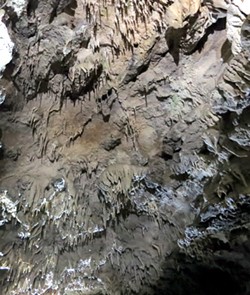[
{
"name": "Top Stories Video Pair",
"insertPoint": "7",
"component": "17087298",
"parentWrapperClass": "fdn-ads-inline-content-block",
"requiredCountToDisplay": "1"
}
]
The Oregon Caves National Monument, just 20 miles east of Cave Junction on Highway 199, is one of the world's few marble caves. "Solutional" caves, that is, caves formed in soluble rock, are almost always found in limestone country. In a nutshell, rainwater absorbs carbon dioxide from the atmosphere forming a weak solution of carbonic acid. As the resulting groundwater flows through natural bedding-planes, joints and faults in the rock, it slowly eats away at the limestone (calcium carbonate) forming, in geologic time, caves. And as the calcium carbonate precipitates out of solution seeping into the caves, beautiful calcite formations, such as flowstones, stalactites, stalagmites, straws, rafts and columns, slowly form.
Marble is what happens to limestone after it's been squished, heated and generally abused deep underground. Geologists believe that the Oregon Caves marble probably originated on the oceanic Pacific Plate as a tropical limestone reef formed from the shells of sea creatures that lived and died some 200 million years ago. Moving east, the Pacific Plate was "subducted" beneath the lighter continental North American Plate scraping the limestone off the descending oceanic crust. The friction between the two plates caused massive heating and deformation some 10 miles below the surface, turning the limestone into marble in a process known as metamorphism. Later, the marble was forced up to around 4,000 feet above sea level.
That's the "Cliff's Notes" geological history. The human history, as far as we know, began in 1874, when hunter Elijah Davidson's dog chased a bear into the cave. Elijah followed, and soon found himself in pitch blackness after the last of his matches gave out. He was eventually able to wade down an ice-cold stream back to daylight. (After a brief dip at the Cave Creek campground, I can attest to the water temperature.) Within a few years, other explorers were venturing farther underground, dazzled, according to contemporary accounts, by the gorgeous calcite formations. The caves became known as "The Marble Halls of Oregon," and were soon being visited by early tourists to the region who threatened their vulnerable beauty. To his credit, in 1909 President Taft invoked the newly-passed Antiquities Act, which set aside the caves and the surrounding forest as a National Monument. The National Park Service, formed in 1916, now administers the entire area, underground and aboveground.
If you haven't visited the Oregon Caves, I do encourage you to do so. Other than early November to late March, it's open year round: call (541) 592-2100 to check on times. Dress warmly for the cave's 44 degrees. The standard guided tour, which lasts about 90 minutes, is a fine introduction to the underworld for us surface-dwellers. And the surrounding country, deep within the Siskyou mountains, isn't too shabby either.
Barry Evans ([email protected]) loves caves, but, unlike his ancestors, wouldn't want to live in one. Thanks to Don Garlick for help with this column.
more from the author
-
A Brief History of Dildos
- Apr 11, 2024
-
Eclipse!
- Mar 28, 2024
-
The Little Drone that Could
- Mar 14, 2024
- More »
Latest in Field Notes
Readers also liked…
-
Trouble on the Line: The Reality Part 2
- Nov 3, 2022

































